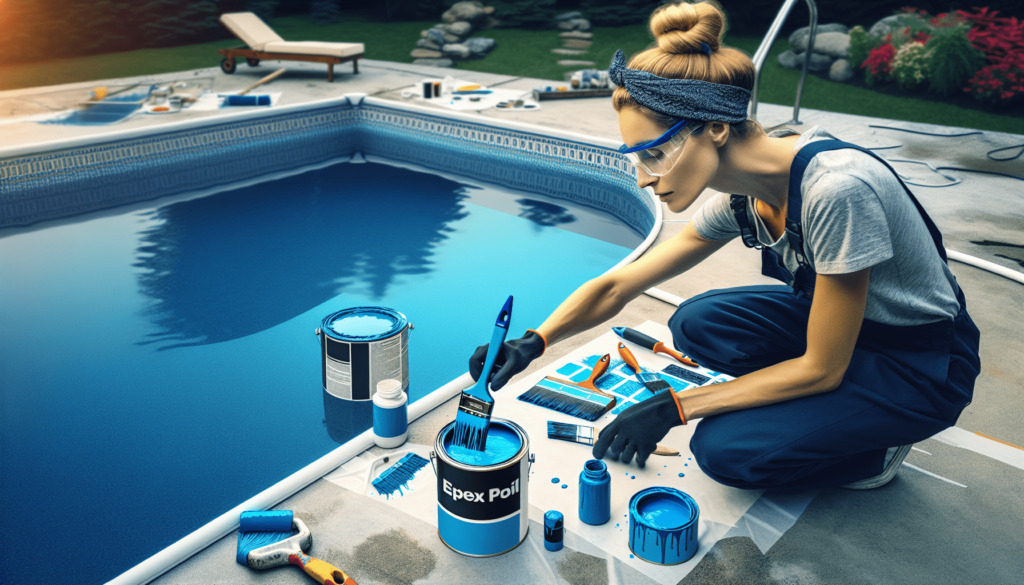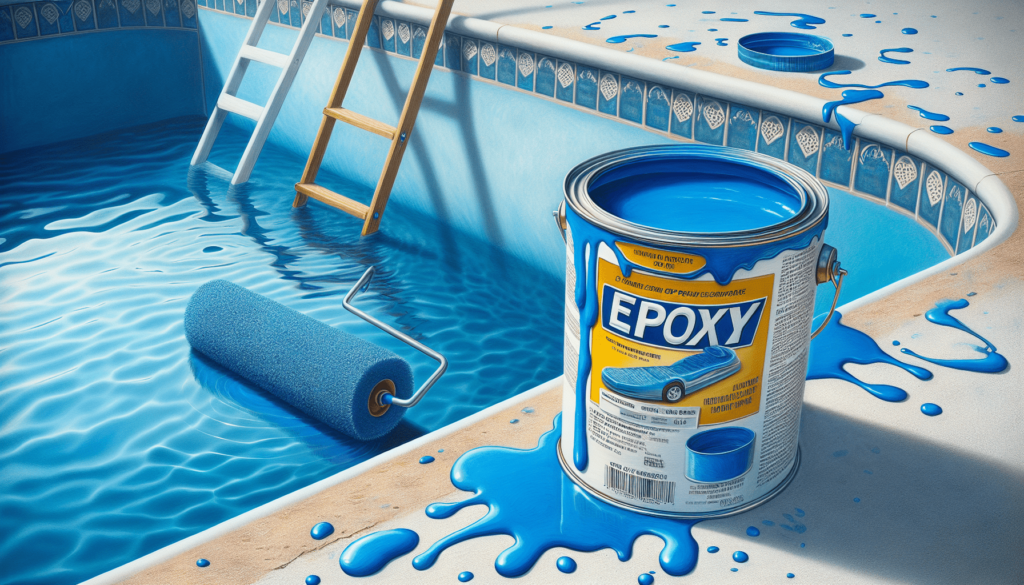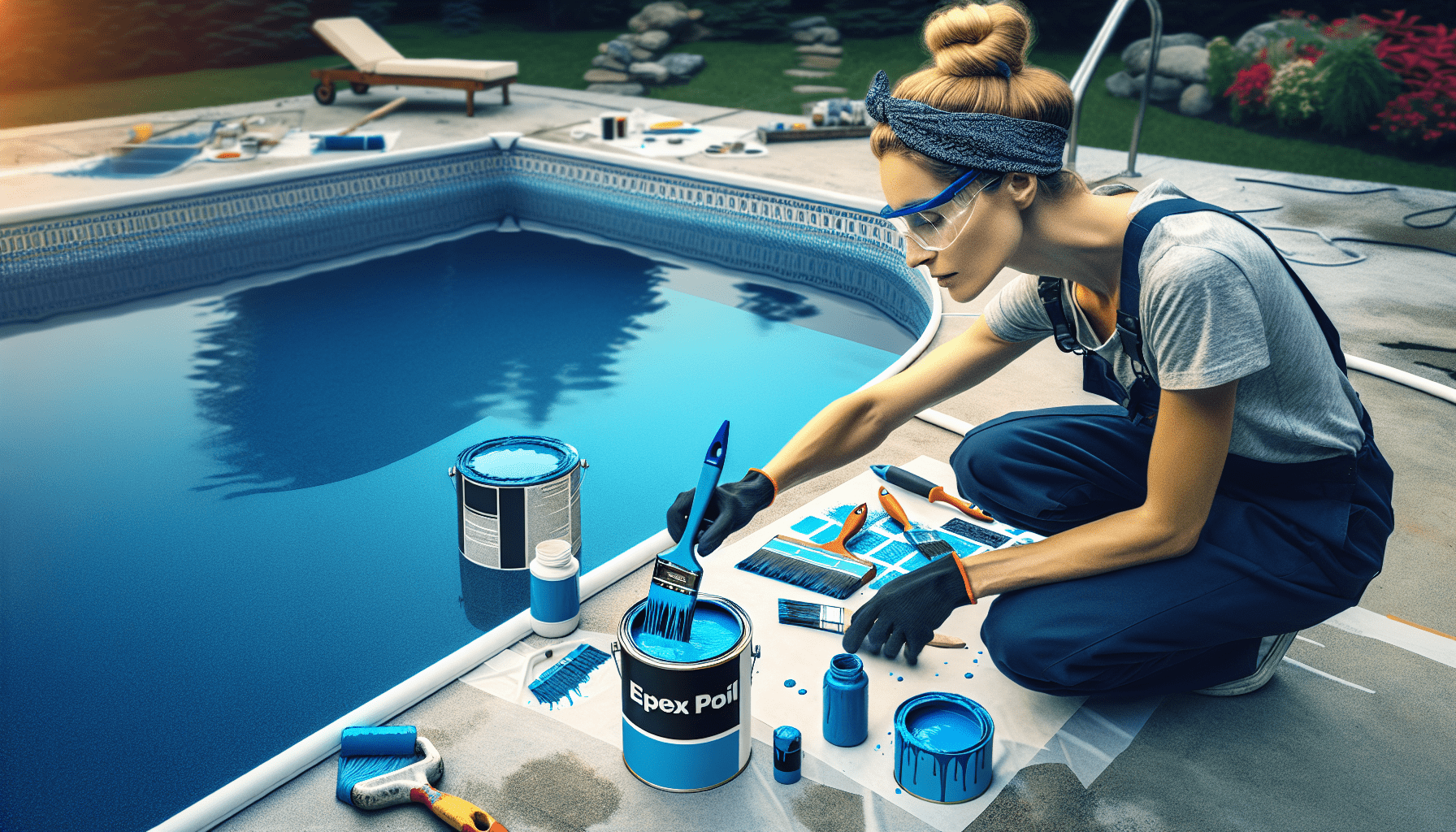In this informative article, you will discover the step-by-step process of successfully painting a swimming pool using epoxy paint. By following these guidelines, you will gain a comprehensive understanding of the necessary materials, preparation techniques, and application methods required to achieve a professional and long-lasting finish. Whether you are a professional pool painter or a homeowner looking to revitalize your swimming pool, this article will provide you with the knowledge and expertise needed to complete the job efficiently and effectively.
Choosing the Right Epoxy Paint
When it comes to painting a swimming pool with epoxy, choosing the right epoxy paint is crucial for a successful and long-lasting paint job. There are different types of epoxy paints available in the market, and it is important to consider the specific needs and requirements of your swimming pool.
Consider the type of epoxy paint
There are different types of epoxy paints that are suitable for various applications. For painting a swimming pool, it is essential to choose an epoxy paint that is specifically designed for this purpose. Look for epoxy paints that are formulated to provide excellent adhesion and durability in wet environments.
Check if it is suitable for swimming pools
Not all epoxy paints are suitable for swimming pools. Some epoxy paints may be designed for industrial or commercial use, while others may be intended for use on different surfaces. Before purchasing an epoxy paint, carefully check the product label or consult with a professional to ensure that it is suitable for swimming pools.
Look for durability and resistance to chemicals and UV rays
Swimming pools are exposed to various elements, including chemicals, sunlight, and water. Therefore, it is important to choose an epoxy paint that is highly durable and resistant to chemicals and UV rays. Look for epoxy paints that have been specifically tested and proven to withstand the harsh conditions of swimming pool environments.
Consider the color options available
In addition to the functional aspects, consider the aesthetic aspect of the epoxy paint. Look for epoxy paints that come in a wide range of color options to suit your preference and complement the overall design of your swimming pool. Remember that the color of the epoxy paint can significantly impact the overall appearance of the pool.
Preparing the Pool Surface
Before applying epoxy paint to your swimming pool, proper preparation of the pool surface is essential. This includes several important steps to ensure that the epoxy paint adheres well and provides a smooth and durable finish.
Drain the pool completely
Before starting the preparation process, ensure that the pool is completely drained. This will allow you to access the entire surface of the pool and ensure thorough cleaning and surface preparation.
Clean the pool surface thoroughly
Once the pool is drained, clean the pool surface thoroughly to remove any dirt, debris, or contaminants. Use a pool brush, along with a mild detergent or pool cleaner, to scrub the entire surface of the pool. Pay special attention to areas with stubborn stains or algae growth.
Remove any existing paint or coatings
If there is any existing paint or coatings on the pool surface, it is crucial to remove them before applying epoxy paint. Use a paint stripper or a suitable stripping agent to remove the old paint. It is recommended to follow the manufacturer’s instructions for the specific product being used.
Repair any cracks or damages in the pool surface
Inspect the pool surface for any cracks, chips, or damages. If any are found, it is important to repair them before proceeding with the epoxy paint application. Use a suitable pool patching material to fill in the cracks or repair any other damages. Ensure that the repaired areas are smooth and level with the rest of the pool surface.
Etch or acid wash the pool surface for better adhesion
To enhance the adhesion of the epoxy paint, it is recommended to etch or acid wash the pool surface. This process involves using an etching solution or muriatic acid to create a rough texture on the surface, which helps the epoxy paint to bond effectively. Follow the manufacturer’s instructions and safety guidelines when performing this step.

Applying Primer
Applying a suitable primer is a crucial step in the process of painting a swimming pool with epoxy. A primer provides better adhesion, enhances the durability of the epoxy paint, and ensures a smoother and more uniform finish.
Choose a suitable primer for epoxy paint
Select a high-quality primer that is specifically designed for use with epoxy paint. Consider the recommendations of the epoxy paint manufacturer or consult with a professional to ensure compatibility between the primer and paint.
Apply the primer evenly on the pool surface
Using a roller or a sprayer, apply the primer evenly across the entire pool surface. Ensure thorough coverage, paying attention to corners, edges, and other hard-to-reach areas. It is important to follow the manufacturer’s instructions regarding the application process, including the recommended thickness of the primer coat.
Allow the primer to dry completely
After applying the primer, allow it to dry completely before proceeding with the epoxy paint application. The drying time may vary depending on various factors, such as temperature and humidity. It is crucial to follow the manufacturer’s instructions regarding the drying time to ensure optimal adhesion and performance of the epoxy paint.
Inspect the primer for any imperfections or issues
Before applying the epoxy paint, inspect the dried primer coat for any imperfections or issues. Look for uneven areas or bubbles that may affect the overall finish. It is important to address any problems at this stage to ensure a smooth and professional-looking paint job.
Mixing and Applying Epoxy Paint
Once the primer is dry and any imperfections are addressed, it is time to mix and apply the epoxy paint. Following the manufacturer’s instructions and guidelines is crucial to achieve the best results.
Read and follow the manufacturer’s instructions
Before starting the mixing and application process, carefully read and understand the manufacturer’s instructions for the specific epoxy paint being used. Pay attention to the recommended mixing ratios, application techniques, and drying conditions.
Mix the epoxy paint components properly
Properly mix the epoxy paint components to ensure a homogeneous mixture. Use a clean and dry container or mixing paddle. Follow the manufacturer’s instructions regarding the mixing process, including the mixing time and speed. Improper mixing can result in uneven color, poor adhesion, or other issues with the epoxy paint.
Apply the epoxy paint using a roller or sprayer
For applying the epoxy paint, use a high-quality roller or sprayer. Each tool has its advantages and limitations, and it is important to select the one that suits your specific project requirements. Follow the manufacturer’s recommendations for the application technique to achieve the desired finish.
Ensure even coverage and avoid drips or pooling
When applying the epoxy paint, ensure even coverage across the entire pool surface. Avoid applying excessively thick coats that can lead to drips or pooling. Work systematically in small sections, ensuring that the applied paint blends smoothly with the previously painted areas.
Work in small sections and follow a systematic pattern
To achieve a uniform finish, it is recommended to work in small sections at a time. By dividing the pool surface into manageable areas, you can ensure consistent application and avoid mistakes or inconsistencies. Follow a systematic pattern, such as starting from one corner and moving in rows or columns.
Apply multiple coats if necessary
Depending on the specific epoxy paint and the desired finish, it may be necessary to apply multiple coats. Each coat should be applied after the previous one has dried, according to the manufacturer’s instructions. Applying multiple coats improves the durability and longevity of the epoxy paint.
Allow each coat to dry as per manufacturer’s instructions
After applying each coat of epoxy paint, allow it to dry completely based on the manufacturer’s instructions. The drying time may vary depending on various factors, such as temperature and humidity. It is important to provide proper ventilation during the drying process to ensure optimal curing and performance.

Curing and Drying
Proper curing and drying of the epoxy paint are essential for its longevity and performance. It is important to follow the recommended curing guidelines to achieve the best results.
Allow the epoxy paint to cure for the recommended time
After the final coat of epoxy paint is applied, it is crucial to allow it to cure for the recommended time. Curing time can vary depending on the product and environmental conditions. Avoid any water contact or usage of the pool until the epoxy paint is fully cured to ensure its durability and longevity.
Ensure proper ventilation during the curing process
During the curing process, ensure proper ventilation in the pool area. This helps in expediting the drying process and preventing the accumulation of fumes or odors. Open windows or use fans to promote air circulation, following the manufacturer’s instructions and safety guidelines.
Keep the pool area clean to avoid debris or dust settling on the paint
To ensure a smooth and clean finish, it is important to keep the pool area free from debris or dust during the curing process. Regularly sweep or vacuum the surrounding area to prevent any particles from settling on the freshly painted surface. A clean environment helps in maintaining the quality and appearance of the epoxy paint.
Avoid any water contact until the paint is fully cured
It is crucial to avoid any water contact or usage of the pool until the epoxy paint is fully cured. Premature exposure to water can negatively affect the curing process and compromise the durability of the paint. Follow the manufacturer’s recommendations regarding the curing time and conditions for optimal results.
Check the paint’s drying time and conditions for optimal results
Different epoxy paints may have varying drying times and conditions. It is important to check the product label or the manufacturer’s instructions for specific information regarding the drying time and conditions. By adhering to the recommended guidelines, you can ensure that the epoxy paint dries properly and provides the desired finish.
Maintaining and Extending the Lifespan
Proper maintenance of the epoxy painted pool surface is essential to extend its lifespan and keep it looking beautiful. By following some simple steps, you can ensure the longevity and durability of the paint job.
Regularly clean the pool to remove debris and prevent staining
Regular cleaning of the pool is crucial to remove debris, leaves, or other foreign objects that may accumulate on the painted surface. Use a pool skimmer or net to remove any floating debris, and regularly vacuum the pool to keep it clean. Preventing the accumulation of dirt and debris helps in maintaining the integrity of the epoxy paint.
Avoid using abrasive cleaners or harsh chemicals
When cleaning the pool surface, avoid using abrasive cleaners or harsh chemicals that may damage the epoxy paint. Use mild cleaners specifically formulated for pool use, and follow the manufacturer’s instructions regarding the cleaning process. Harsh chemicals or abrasive cleaners can cause discoloration or degradation of the paint.
Check and repair any damages to the epoxy paint
Regularly inspect the pool surface for any damages, such as chips, scratches, or peeling. Promptly address any issues by repairing the damaged areas. Use a suitable pool paint repair kit or consult with a professional to ensure proper repairs that match the existing epoxy paint.
Apply a fresh coat of epoxy paint when needed
Over time, the epoxy paint may start to fade or show signs of wear. When this occurs, it is recommended to apply a fresh coat of epoxy paint to restore the appearance and protect the underlying surface. Follow the proper surface preparation and application steps outlined previously to ensure a successful repaint.
Consider using a pool cover to protect the paint
To further protect the epoxy painted surface, consider using a pool cover when the pool is not in use. A pool cover helps in preventing debris from entering the pool and protects the paint from direct sunlight, reducing the effects of UV exposure. Regular use of a pool cover can significantly extend the lifespan of the epoxy paint.
Safety Precautions
When painting a swimming pool with epoxy, it is important to prioritize safety. Follow these safety precautions to ensure a safe and successful paint job.
Wear appropriate protective gear while painting
Before starting the painting process, ensure that you wear appropriate protective gear. This includes safety goggles, gloves, and a respirator mask to protect yourself from fumes, chemicals, and other potential hazards.
Ensure proper ventilation in the painting area
Maintain proper ventilation in the painting area to prevent the build-up of fumes or odors. Open windows or use fans to promote air circulation. If possible, work in an outdoor or well-ventilated area to minimize the exposure to fumes.
Follow all safety precautions provided by the manufacturer
Carefully read and follow all safety precautions and guidelines provided by the manufacturer of the epoxy paint. This includes proper handling, storage, and disposal of the paint and associated materials. Adhering to safety guidelines minimizes the risk of accidents or health hazards.
Keep children and pets away from the pool during the painting process
To ensure the safety of children and pets, keep them away from the pool area during the painting process. Restrict access to the pool until the epoxy paint is fully cured and safe for use. Communicate the importance of staying away from the painted pool to ensure everyone’s well-being.
Dispose of any leftover paint and materials responsibly
After completing the painting project, dispose of any leftover paint and materials responsibly. Follow local regulations and guidelines for the proper disposal of hazardous waste. Do not pour paint or other materials down drains or dispose of them in regular trash bins.
Hiring a Professional
For larger or complex pool painting projects, hiring a professional can save time and ensure a high-quality result. Consider these factors when choosing a professional pool painting contractor.
Consider hiring a professional for larger or complex pool projects
If you have a large swimming pool or if the project involves complex surface repairs or other challenges, it may be beneficial to hire a professional pool painting contractor. Professionals have the necessary expertise, equipment, and experience to handle such projects effectively.
Research and choose a reputable pool painting contractor
Before hiring a pool painting contractor, conduct thorough research and gather recommendations from trusted sources. Look for contractors with a proven track record of successfully completing pool painting projects. Read reviews and testimonials from previous customers to gauge their reputation and reliability.
Get multiple quotes and compare the services offered
Obtain multiple quotes from different pool painting contractors to get an idea of the pricing and services offered. Compare the quotes based on factors such as experience, warranty, customer reviews, and the use of high-quality materials. Choose a contractor who offers competitive pricing and meets your specific requirements.
Ensure the contractor has experience with epoxy pool painting
Verify that the pool painting contractor has experience specifically with epoxy pool painting. Epoxy painting requires specialized techniques and knowledge, and it is important to choose a contractor who is well-versed in this specific type of paint application.
Review their previous work and customer feedback
Ask the pool painting contractor for references or examples of their previous work. Review their portfolio or visit sites where they have previously painted pools to assess the quality of their work. Additionally, read customer reviews or testimonials to understand their level of professionalism and customer satisfaction.
Common Mistakes to Avoid
To ensure a successful pool painting project, it is important to avoid common mistakes that can negatively impact the paint job’s quality and durability.
Applying paint in unsuitable weather conditions
Take into account the weather conditions before starting the pool painting project. Avoid painting during rainy or extremely hot weather, as these conditions can affect the adhesion and drying of the epoxy paint. Follow the manufacturer’s recommendations regarding temperature and humidity limits.
Skipping or improper surface preparation
Proper surface preparation is crucial for the adhesion and durability of the epoxy paint. Skipping or rushing through this step can result in paint failure and other issues. Take the time to thoroughly clean, repair, and prepare the pool surface before applying the epoxy paint.
Not following manufacturer’s instructions and recommended cure time
Manufacturers provide specific instructions and recommendations for their epoxy paint products. It is important to carefully read and follow these instructions, including the recommended cure time. Deviating from the instructions can compromise the quality and longevity of the paint job.
Applying insufficient or uneven coats of epoxy paint
To achieve a durable and professional-looking finish, it is essential to apply sufficient and even coats of epoxy paint. Applying thin coats or missing certain areas can result in weak spots or an uneven appearance. Follow the proper application technique and guidelines for optimal results.
Using incompatible or low-quality paint and materials
Using incompatible or low-quality epoxy paint and materials can result in poor adhesion, color inconsistency, or premature degradation. It is important to choose high-quality epoxy paint that is specifically designed for swimming pool surfaces. Additionally, use the recommended primers, rollers, sprayers, and other materials for optimal performance.
Conclusion
Painting a swimming pool with epoxy paint requires careful consideration, proper preparation, and precise application techniques. By choosing the right epoxy paint, thoroughly preparing the pool surface, applying suitable primers and multiple coats of epoxy paint, and following the recommended curing and drying guidelines, you can achieve a beautiful and long-lasting paint job.
Regular maintenance, such as cleaning the pool surface, avoiding abrasive cleaners, repairing damages, and applying fresh coats of epoxy paint when needed, will help extend the lifespan of the painted pool surface.
If you have a larger or more complex pool painting project, it is advisable to hire a professional pool painting contractor with experience in epoxy pool painting. Conduct thorough research, obtain multiple quotes, and review the contractor’s previous work and customer feedback to ensure you choose a reputable and reliable professional.
By avoiding common mistakes and following the safety precautions provided, you can successfully paint your swimming pool with epoxy and enjoy a beautiful, durable, and well-maintained pool for years to come.



